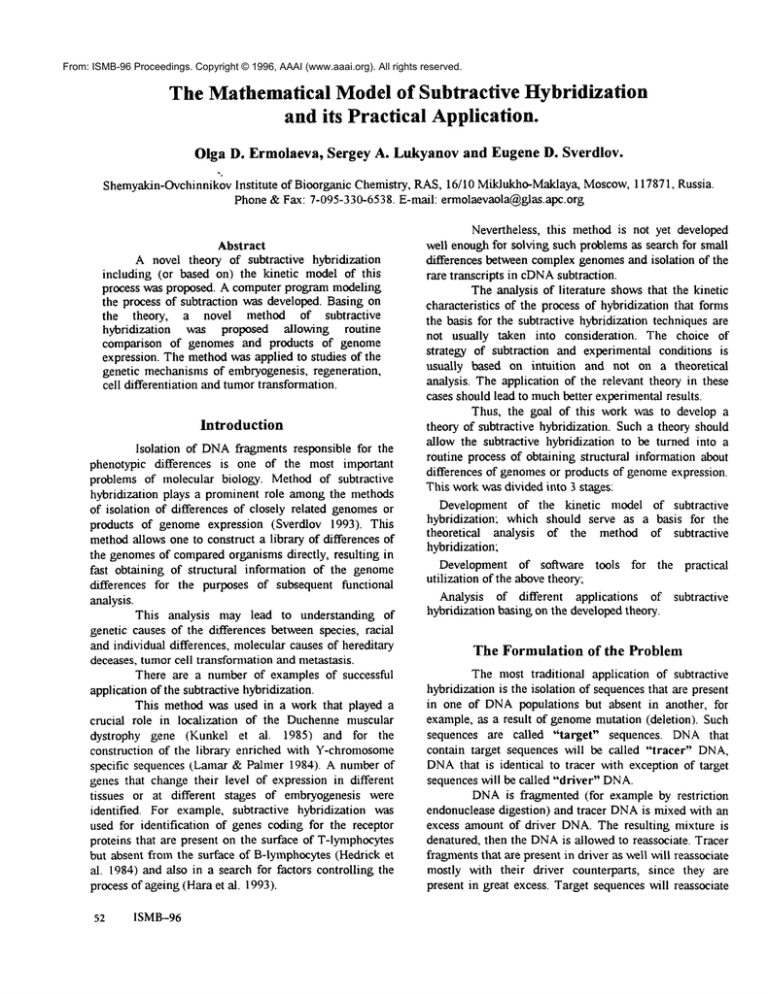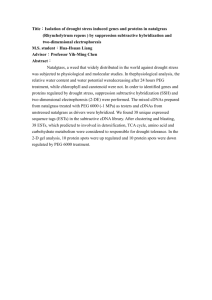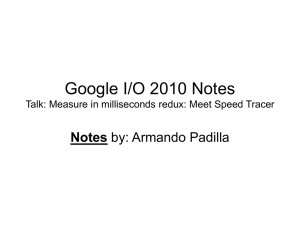
From: ISMB-96 Proceedings. Copyright © 1996, AAAI (www.aaai.org). All rights reserved.
The Mathematical Model of Subtractive Hybridization
and its Practical Application.
Olga D. Ermolaeva,
Sergey
A. Lukyanov and Eugene D. Sverdlov.
Shemyakin-Ovchinnikov Institute of Bioorganic Chemistry, RAS,16/10 Miklukho-Maklaya,Moscow,117871, Russia.
Phone & Fax: 7-095-330-6538. E-mail: ermolaevaola@glas.apc.org
Abstract
A novel theory of subtractive hybridization
including (or based on) the kinetic model of this
process was proposed. A computer program modeling
the process of subtraction was developed. Basing on
the theory, a novel method of subtractive
hybridization
was proposed allowing routine
comparison of genomes and products of genome
expression. The methodwas applied to studies of the
genetic mechanismsof embryogenesis, regeneration,
cell differentiation and tumortransformation.
Introduction
Isolation of DNAfragments responsible for the
phenotypic differences is one of the most important
problems of molecular biology. Method of subtractive
hybridization plays a prominent role amongthe methods
of isolation of differences of closely related genomesor
products of genome expression (Sverdlov 1993). This
methodallows one to construct a library of differences of
the genomesof comparedorganisms directly, resulting in
fast obtaining of structural information of the genome
differences for the purposes of subsequent functional
analysis.
This analysis may lead to understanding of
genetic causes of the differences between species, racial
and individual differences, molecular causes of hereditary
deceases, tumor cell transformation and metastasis.
There are a number of exanlples of successful
application of the subtractive hybridization.
This method was used in a work that played a
crucial role in localization of the Duchenne muscular
dystrophy gene (Kunkel et al. 1985) and for the
construction of the library enriched with Y-chromosome
specific sequences (Lamar & Palmer 1984). A number
genes that change their level of expression in different
tissues or at different stages of embryogenesis were
identified. For example, subtractive hybridization was
used for identification of genes coding for the receptor
proteins that are present on the surface of T-lymphocytes
but absent from the surface of B-lymphocytes(Hedrick et
al. 1984) and also in a search for factors controlling the
process of ageing (Hara et al. 1993).
52 ISMB--96
Nevertheless, this method is not yet developed
well enough for solving such problems as search for small
differences between complexgenomesand isolation of the
rare transcripts in cDNA
subtraction.
The analysis of literature showsthat the kinetic
characteristics of the process of hybridization that forms
the basis for the subtractive hybridization techniques are
not usually taken into consideration. The choice of
strategy of subtraction and experimental conditions is
usually based on intuition and not on a theoretical
analysis. The application of the relevant theory in these
cases should lead to muchbetter experimentalresults.
Thus, the goal of this work was to develop a
theory of subtractive hybridization. Such a theory should
allow the subtractive hybridization to be turned into a
routine process of obtaining structural information about
differences of genomesor products of genuine expression.
This work was divided into 3 stages:
Development of the kinetic model of subtractive
hybridization; which should serve as a basis for the
theoretical
analysis of the method of subtraclive
hybridization;
Development of software tools for the practical
utilization of the abovetheory;
Analysis of different applications of subtractive
hybridization basing on the developedtheory.
The Formulation
of the Problem
The most traditional application of subtractive
hybridization is the isolation of sequencesthat are present
in one of DNApopulations but absent in another, for
example, as a result of genomemutation (deletion). Such
sequences are called "target" sequences. DNAthat
contain target sequences will be called "tracer" DNA,
DNAthat is identical to tracer with exception of target
sequences will be called "driver" DNA.
DNAis fragmented (for exaniple by restriction
endonuclease digestion) and tracer DNAis mixed with an
excess amount of driver DNA.The resulting mixture is
denatured, then the DNAis allowed to reassociate. Tracer
fragmentsthat are present in driver as well will reassociate
mostly with their driver counterparts, since they are
present in great excess. Target sequences will reassociate
with each other. Duplexes that contain DNAfragments
conunon for tracer and driver are removed. The remaining
DNAis enriched with target molecules. This DNAis
cloned and analyzed. This type of the target will be called
the "absolute" target.
The practical
implementation
of such an
approach requires a way to estimate the achieved
enrichment and content of target sequences in the
resulting library.
Subtractive hybridization may be also used for
isolation of sequences that are present both in driver and
in tracer but in different abundance. Such a problem often
arises during subtraction of cDNAlibraries for the
determination of the differences in levels of gene
expression in closely related cell types. This type of the
target will be called the "copied"target.
Subtractive hybridization maybe used also for the
isolation of homologoussequences present both in driver
and tracer.
This type of target will be called
"homologous"target.
All reported methods for the genomesubtraction
utilized the same strategy - the subtraction of doublestranded tracer and double-stranded driver. In principle,
other strategies may be employed. For example, it is
possible to use single-stranded tracer and single-stranded
driver that is complementaryto tracer. In this case target
sequences do not have counterparts neither in tracer nor in
driver and their concentration remains constant. So it is
possible to reach greater degree of enrichment after the
removalof duplexes.
In this work we have analyzed the process of
subtractive hybridization for the following cases:
absolute target:
copied target;
homologoustarget.
For all target types we have analyzed 5
subtraction strategies:
1. double-stranded driver and double-stranded tracer;
2. single-stranded tracer and double-stranded driver;
3. single-stranded tracer and complementary singlestranded driver;
4. double-stranded tracer and driver that is unable for
reassociation;
5. double-stranded tracer and single-stranded driver.
(Sverdlov & Ermolaeva 1993, Sverdlov & Ermolaeva
1994). It consists of a system of differential equations
describing the kinetics of DNAreassociation in solution.
A number of factors (such as salt concentration,
temperature, DNAfragment length etc.) are also taken
into consideration.
Let us introduce the following designations:
D, T, U, W- molar concentrations of fragments
of driver, fragments of tracer that are present in driver,
fragments of target in tracer, and fragments of target in
driver, respectively;
d, s - indices, corresponding to double-stranded
and single-stranded DNA,for exampleUs, Td, DS;
uS(t), DS(t) - the concentrations as a function
time;
U0, TO- the initial concentrations of singlestrandedDNA;
Es, Ed - the enrichment in single-stranded and
double-stranded DNAfractions respectively;
R, M"1 os" 1 _ the rate of reassociation.
R ~ 106 M"1 .s" 1 for the fragmentswith length ~,
500 nucleotides in 0.18 MNaCI at optimal temperature
equal to Tin- 25°C (Britten & Davidson 1985). R1 - the
reassociation rate for the fragments that do not share
100% homology.
The kinetics of the process of subtractive
hybridization is described by the following systems of
differential equations:
(1):
[dD~(t)
__ _ -a 00RDS(t)DS(t)- a01RDS(t)T~
dt
dDd(t)
-- - al0RDS(t)D~(t)
dt
dT~(t)
-- _ -a20RT~(t)T~(t)- a21RD~(t)T~(t)
dt
dT~(t)
- a 30RTs (t)T ~ (t)
dt
--
D~(0) = 0, Dd(0) =
The Kinetic Model of Subtractive
Hybridization
T~(0) = 0, Td(0) =
The proposed kinetic model of subtractive
hybridization is based on the assumption that the rate of
the formation of driver-driver, tracer-tracer and driver
tracer duplexes is described by the second order equation
Ermolaeva
53
A numberof individual
mRNAsequences
CLASS
High-abundant
Medium-abundant
Low-abundant
12
330
6400
A numberof copies of
individual mRNA
sequencesper cell.
7200
250
21
%content of a given
mRNAsequence
relative to total mRNA.
2.4
2
8.24.10
-3
6.92.10
Table 1. Different classes of cytoplasmic poly(A)+-mRNA
in mammalian
cells (Galau et al. 1977).
(2):
dW~(t)
__ _ -booRW~(t)W~(t)dt
bolRW~(t)U"(t)
dWd(t)
__ _ b,oRW~(t)W~(t)
dt
dU~(t)
~ (t)U ’ (t) -b21 ~ (t )U ’ (t
-- -b 2oRU
dt
dUd(t)
dt
_ b3oRU~(t)U~(t)
W~(0) = 0, W
a(0) =
US(0) = 0, Ua(0) =
U~(t)
Es(t) - TS(t),
Ua(t)
¯Ed(t)- Ta(t)
For each case the coefficients aij, bij of the
systems of differential equations (1), (2) are different
equal to 0 or 1, since, for example,if driver and tracer are
single-stranded, driver is able to reassociate with tracer but
is not able to reassociate with itself. In case of absolute and
copied target Rl=Rand in case of absolute target W0=0.
System (1) has solutions in elementary functions
assumingthat the concentration of driver is muchgreater
than the concentration of tracer. In somecases system (.2)
has no solutions even if the concentration of driver greatly
exceeds that of tracer.
This made us to write a
SUBTRACTsoftware package that implements the
modeling of subtractive hybridization. The user-friendly
interface of this program developed by Mark Wagner
(Ermolaeva & Wagner 1995) allows the casual user
choose optimal experimental conditions and strategy of
subtraction.
The program was developed on Sun
Microsystems hardware using the standard C language.
The Motif widget system (version 1.0) was used
54
ISMB-96
implement the independent windows and controls. The
actual drawing system was mplemented using the XII
Windowsystem (Release 5). This gives SUBTRACT
the
ability to be run over the network, with the code being run
on one workstation and the interface being displayed on
any system that can display X Windows.
Analysis
of Different
Subtraction
Approaches
The SUBTRACT
program allowed us to perform
additional analysis of subtraction of genomesand cDNA
libraries leading to unexpectedconclusions and to propose
moreeffective approachesto subtractive hybridization.
a) The Subtractive Hybridization of Transcripts
The subtractive hybridization approach is widely
used for isolation of transcripts that are present in some
cells and absent in other, closely related, cells.
Nevertheless this methodis not yet well suited for the
isolation of transcripts that are present in very small
amounts (Lukyanov et al. 1994). One of the major
problemsin isolation of the rare transcripts is the fact that
different nu~NAclasses are present in cells in different
amounts.
The cellular mRNAscan be subdivided into 3
classes (see table 1): high-abundant, medium-abundant
and low-abundant (Galau et al. 1977). Molecules of the
first class are produced by 10 to 20 genes, mammalian
cells contain a few thousands copies of each of these
transcripts. Moleculesof the second class are transcribed
from several hundred genes and cells typically contain
several hundred copies of each of these transcripts. Most
genes, however,produceonly a few transcripts per cell.
The cDNA
subtraction strategies proposed earlier
were not developedspecifically for search for a targets of
the specific mRNA
class. It is obvious that search for
membersof different classes calls for different strategies.
Thus it would be desirable to develop specific strategy
optimized for a given task, for example, for the search for
rare transcripts.
Wehave analyzed the most widely used approach
to cDNAsubtraction (Sverdlov & Ermolaeva 1994). This
I00
-
I00
v
2,4
0
o
2,4
O,I
0,01
0,3%
0,2%
0,1
¢..-
0,01
............................................................
5
10
J
15
20
TimeCa)
5
10
15
20
Time(h)
A°
00 "’-
30%
2,4
O
O
91 ~ .......
0,01
2,4
1,5%
0,1
- O,O9%
0,01
5
10
15
20
Time(h)
5
10
15
20
Time (h)
B°
Figure 1. Thecontent of target sequencesin single-straned (A) and double-stranded(B) DNA
fractions after
the first roundof subtraction. Time- the hybridizationtime (in hours). Content- the contentof the particular
sequencesbelongingto high-, mediumand low-abundantmRNA
classes (top to bottom, relative to total DNA
amount)
approachis used for the search for mRNA
moleculesthat
are present in one type of cells but absent from another
type and is based on subtraction of double-strandedtracer
a~ainst double-stranded
driver.
Our calculations show that the resulting
enrichmentwill be different for different classes of target
molecules (whether target molecules belong to highabundant, medium-abundant
or low-abundantclass).
Fig. 1Apresents the results of calculations for
single-stranded fraction of tracer showingnormalization
of concentrationsof different types of moleculesfor this
fraction. After 20 hoursof hybridizationcontentof highlyabundanttarget is 8 times less than in the beginning,of
middle-abundant target - 3 times more and of lowabundanttarget - 20 times more.
Fig. 1Bpresents similar results for the doublestrandedfraction of the tracer. In this fraction wecan see a
dramaticincrease of the content of high abundanttarget,
which constitutes
up to 30% of total DNA. The
concentrationof low-abundanttarget is 9 times morethan
in the beginning,
but still is quitelow.
The obvious conclusion is that the doable- and
single strandedfractions of tracer shouldbe separatedafter
the first roundof subtraction. Thedouble-stranded
fraction
can be cloned producing a library with high content of
targets originating from high-abundant mRNA.The
single-stranded fraction should be used in subsequent
subtractionroundsfor isolation of targets originatingfrom
low-abundant mRNA.
Fig. 2 presents the content of target sequencesin
double-andsingle strandedfractions of tracer after second
Ermolaeva
55
100
100
30%
27%
12%
2,4
2,4
2%
8 0,1
1,5% 0,l
0,01
0,01
i
5
10
J
!
.......
15
20
5
10
15
20
Time(h)
Time (h)
Figure 2. The content of target sequences in single-stranded (left) and double-stranded (right) fractions
DNAafter second round of subtraction. Time- the hybridization time (in hours). Content - the content
the particular sequences belonging to high-, medium- and low-abundant mRNA
classes (top to bottom,
relative to total DNAamount).
round of subtraction. In this case double-stranded fraction
is highly enriched in target sequences originating from all
3 mRNA
classes.
About 30%of all DNAfragments in this fraction
originate
from high-abundant
mRNA, 27%
from
medium-abundant and 12% - from low-abundant
Thus, 2 cycles of subtraction should suffice for
obtaining a cDNAlibrary with high enough representation
of rare target sequences. In order to achieve this goal one
should save the single-stranded fraction of not reassociated
~" Subtraction
!iiiiii
iiiii!i
ii!iii!
iii!i!ii!iiiiiiiiiiiiiiiiiiiiiiiii!ii
iiiiiiiii!iiiii
iiiiiiiiiiiiii!iii
ii!iiiiiiiii
::::::::::::::::::::::::::::::::::::::::::::::::::::::
:::::::::::: :.:.::::::::::::::::::::::::
: ::::::::::.:::.:
:.:.:.:-:.:.:-~:~
#:.’..
~:::~::::::::::::::
.~:.:.:.>:..:.:...:...:.:.:.:.
:::~:":":k:.:~:~:~:i:~:i:i:i:~:i:i:~:~:i~!~:~:!~;~!:~!~!~]!:!~ii!~:!~i:;ii:i:i:.~...
":i:i:~:i:i:
~~:i:i:
i:i:i:i:i:i:i:i:i
i.::i
i::::
i.::~:i
i:::i:i:i:i:i:i:i:;iiii:ii;:i:i:~:i:;:i:~:i:i:i:i:i:i:i:i:i:i:i:i:i:3"
:::::::::::::::::::::::::::::::::
i:iii~:.i!.:~!:i
ii’ii:iii!i:i!i!i.ii:i:i:!i!~:!!:!!:ii~ii!iiiii!i:iiiii:iiiii:!
i~
~:i:i:i:i:i:i:i:i:
:i:!:i:i:!:
."ii:i!iii~
~i!iiiiiii
fill.
iii::i:~:.i:i:~:?i:::!:iiiii!iii!i:iiii
i:!:!.i.i:i:i.!:~:i~i:i:!ii:~
~
~
!!!ii:i:i
i!i!i
!::!!::i:i
ii:i::!:ii
:i:i!
i:!::!:!
!:i:!i!:::i~i~i!!i..’.’!ii!ii!!!i!iii:ii!i~::~.
.:.:...:.:.:.:
:...:.:..:
.:.:...:.:.:.:.:.:.:.:.:.:.:...:.:.:.:.:.:.:.:.:.:.~:.:..
, !~.....::
.:..:.
i::i~:i:i~
:?:::":
"""
"""
"""
"::::~ii:ii~iiii
ii:~i!:ii:i:i:~
:i::~ 3~i~:.::i:~:::’:’:’:’:’:’:’:’:’:’:
::::::~
~:~::~:~:::: ::::::~
~:::::i:i:~i:
:.:.:.:.:.::.,".:.
::~::::,x
ilii
iiiii
,i’,ii
A
B
Figure 3, A. Lane I - DNAsize marker (100 bp ladder) The next lane - tracer DNA(,muscle cDNA
containing 0. I% of d~X174DNAdigested with HaeIII) followed by three lanes with products of subtraction of
muscle cDNAcontaining phage DNAin amount equivalent to 100, l0 and 1 copies per cell. The last lane HaeIII digest of d~X174DNA.B. Lane l - tracer (cDNAfrom Jurkat cells activated by PGA),lane 2 - driver
(cDNA
from not-activated cells), lane 3 - subtraction results.
56
ISMB-96
Case
3
1000
4 ss
100
4 ds
10
1; 2
5 10 15 20 25 30 35 40 45 50
Time (h)
Figure 4. The expected enrichment of target for different strategies of subtractive hybridization. Time- the
hybridization time (in hours). Enrichment- the enrichment of the target sequence. 1 - double-stranded driver
and double-stranded tracer; 2 -single-stranded tracer and double-stranded driver; 3 - single-stranded tracer and
complementary
single-stranded driver; 4 - double-stranded tracer and driver that is unable for reassociation; 5 double-stranded tracer and single-stranded driver.
tracer moleculesafter the first round in subtraction for use
in additional subtraction rounds. In following rounds a
double-strandedfraction of tracer should be saved.
Isolation of single-stranded molecules can be
achieved by different means, for example by physical
separation of single- and double stranded DNAafter
hybridization. Howevera specific amplification of singlestranded DNAand not double-stranded DNAseems to be
moreeffective.
One of variants of the latter approach was used in
a strategy for the isolation of rare transcripts that we
developed on the base of proposed theory (Lukyanovet al.
1994). The PCRprimers of particular structure that allow
us to amplify only single-stranded fraction of tracer were
used. Weperformed a theoretical analysis of the proposed
strategy and estimated the expected enrichment.
The experimental results of this scheme are
presented in Fig. 3. Phage DNAwas added to muscle
cDNAas a target (Fig. 3a) in an amountcorresponding
1, 10 and 100 copies per cell and can be considered to
belong to low- and medium-abundant mRNA
classes. The
resulting enrichmentwas about 100 times for the first case
and at least 1000 times for the second case, in agreement
with the theoretical prediction.
The practical applicability of this scheme was
additionally verified by. isolation of gene transcripts that
are synthesized in Jurkat cells upon PGAactivation, such
as IL-2 receptor. The results of the comparisonof content
of IL-2 receptor cDNAprepared from activated and
normal cells and subtraction products are presented in
Fig. 3b.
b) Genome Subtraction
Wealso applied the proposed kinetic model to
theoretical analysis of the process of genomesubtraction
(Sverdlov & Ermolaeva 1993). Despite the fact that the
subtractive hybridization is widely used for the comparison
of genomes,no reliable methodsfor the isolation of small
differences between complex genomeswere developed.
The most widely used strategy for the genome
subtraction is the hybridization of double-stranded driver
and double-stranded tracer. The comparison of the
enrichmentfor all strategies of subtraction is presented in
Fig. 4. Our data showthat the use of single-stranded tracer
and complementarysingle-stranded driver should results
in higher enrichmentthan the use of alternative strategies.
In this case after 30 hours of hybridization the enrichment
of target should be about 120 times, whereas the
traditional
strategy should result only in 6-fold
enrichment.
Ermolaeva
57
Wepropose an optimal strategy for the genome
subtraction which includes the use of single-stranded
tracer and single-stranded driver complementaryto tracer.
The development of this strategy should allow for the
direct isolation of small differences between complex
genomeswithout the preliminary stages which bring the
dangerof losing the difference to be sougllt.
Conclusion
Our experience in application of the proposed
theory to several cases of subtractive hybridization shows
that it adequately describes the process of subtraction
experiment. One of the major advantages of this theory is
it’s universality. It can be applied to determination of the
experimental conditions for existing strategies
of
subtractive hybridization and for the analysis of the
viability, of the novel strategies for the search of specific
differences as well.
Acknowledgments
The authors are grateful to K. Lukyanovand N.
Gurskaya for kind permission to use figure 3. Wealso
would like to thank Dr. S. Volik for translation of
manuscript.
References
Britten, R. J.; and Davidson, E. H. 1985. Hybridisation
strategy. In Hames,B. D.~ and Higgins S. J. (eds), Nucleic
acid hybridisation. IRL Press, Oxford-WashingtonDC, 314.
Ermolaeva, O. D.; and Wagner, M. C. 1995. SUBTRACT,
a computer program for modeling the process of
subtractive hybridization. CABIOS11: 457-462.
Galau, G. A.; Klein, W.H.: Britten, R. J.: and David,son,
E. H. 1977. Significance of rare mRNA
sequences in liver.
Archives of lJiochemistr!’ and Biophysics 179: 584-599.
Hara, E.; Yamaguchi, T.; Tahara, H.: Tsuyama, N.;
Tsurui, H.; Ide, T.; and Oda K. 1993. DNA-DNA
subtractive cDNAcloning using oligo(dT)30 -Latex and
PCR: identification
of cellular
genes which are
overexpressed in senescent humandiploid fibroblasts.
Anal. t3iochem. 214: 58-64.
Hedrick, S. M.; Cohen, D. 1.; Nielsen, E. A.; and Davis,
M. M. 1984. Isolation of cDNAclones encoding T cellspecific membrane-associated proteins. Nature 308: 149153.
Kunkel, L. M.: Monaco, A. P.: Middlesworth, W.: Ochs
Hans, D.; and Latt, S. A. 1985. Specific cloning of DNA
fragjnents absent from the DNAof a male patient with an
X chromosomedeletion. Proc. :Vat. Acad. Sci. USA82:
4778-4782.
58 ISMB--96
Lanlar, E.; and Palmer, E. 1984. Y-encoded, speciesspecific DNAin mice: evidence that the y chromosome
exists in two polymorphicforms in inbred strains. (’ell 37:
171-177.
Lukyanov, S. A.; Gurskaya, N. G.; Lukyanov, K. A.:
Tarabykin, V. S.; and Sverdlov, E. D. 1994. Higldy
efficient subtractive hybridization of cDNA.13ioorg. Khim.
20:701-704.
Sverdlov, E. D. 1993. Subtractive hybridization
technique of extraction of DNAsequences discriminating
between two closely related genomes. Mol. Gen.
3,Iicrobiol. I’irusol. 1-12.
Sverdlov, E. D.: and Ermolaeva, O. D. 1993. Subtractive
hybridization. Theoretical analysis and a principle of the
"trapper". Bioorg. Khim. 19: 1081-1088.
Sverdlov, E. D.: and Ermolaeva O. D. 1994. Kinetic
analysis of subtractive hybridization of transcripts, t3ioo~4.
Khim. 20: 506-514.





